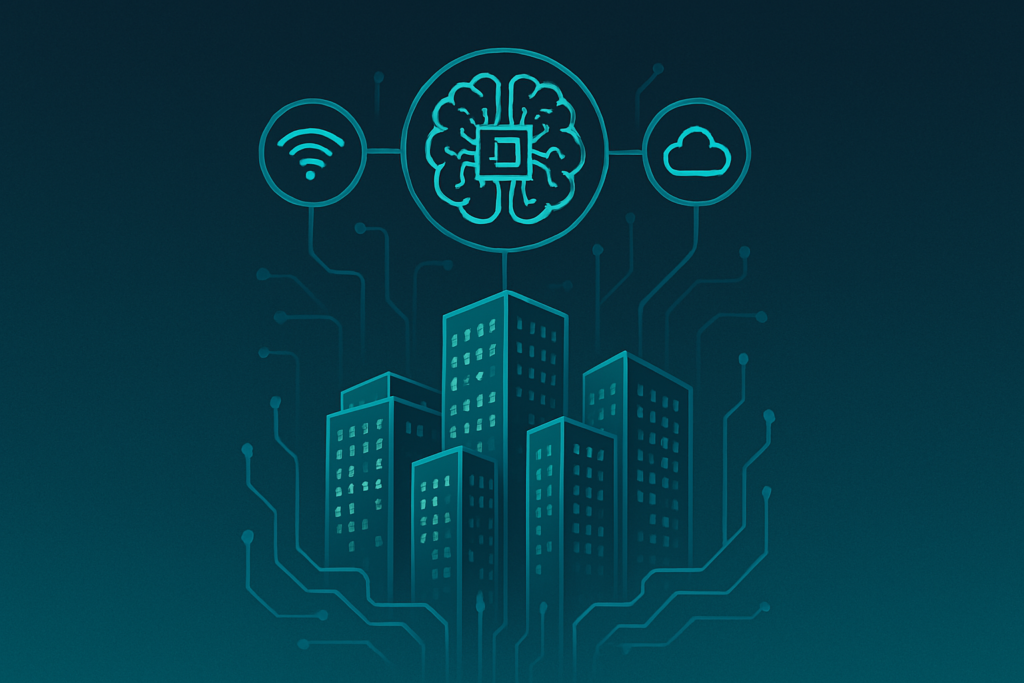April 9 recognizes the Internet of Things. Today, we’re seeing the full realization of a powerful feedback loop in smart buildings: Operational Technology (OT) feeds data to AI, and AI sends optimized commands back to OT systems. This symbiotic relationship, as highlighted in our 2024 IoT post, has now evolved into the central nervous system of modern building automation.
1. The AI-OT Feedback Loop Matures
What’s New in 2025?
- Closed-Loop Autonomous Control – Building on last year’s concepts, systems now complete the full cycle: OT sensors feed real-time data → AI processes and makes decisions → OT actuators execute commands → sensors validate results → AI learns and improves (AutomatedBuildings, 2024).
- Self-Tuning Algorithms – AI no longer just responds to conditions but actively experiments with micro-adjustments to find optimal settings for energy use and comfort (Gartner, 2025).
Impact on Building Automation:
- Elimination of human-set parameters in favor of continuously evolving AI-determined setpoints
- 30-40% faster response to changing conditions compared to 2024 systems
2. Edge AI Becomes the Bridge Between OT and Cloud
Where are We Now?
- Local Decision Hubs – Inspired by the need for real-time OT response highlighted in the AutomatedBuildings article, edge devices now host lightweight AI models that make immediate decisions while still contributing to cloud-based learning (ABI Research, 2025).
- Federated Learning Across OT Networks – Buildings now share learned behaviors without exposing raw data, creating a collective intelligence while maintaining security (IEEE IoT Journal, 2025).
Impact on Building Automation:
- Critical systems like fire safety and elevator control operate with near-zero latency
- Buildings in similar climates/clusters learn from each other’s OT patterns
3. The Sustainability Feedback Loop
What’s New in 2025?
- Dynamic Carbon Accounting – OT systems now feed real-time emissions data to AI, which then adjusts operations to stay within carbon budgets, creating a continuous improvement cycle (McKinsey, 2025).
- AI-Optimized Energy Trading – As predicted in the AutomatedBuildings piece, OT systems not only consume energy but now actively participate in microgrid transactions based on AI analysis of market conditions and building needs (Forrester, 2025).
Impact on Building Automation:
- Buildings achieve net-zero operations 20% faster than 2024 estimates
- Energy costs reduced by an additional 15% through real-time market participation
4. Cybersecurity Evolves to Protect the AI-OT Pipeline
What’s New in 2025?
- AI-Guided OT Hardening – Building on last year’s concerns about the AI-OT connection, new systems use AI to constantly probe and reinforce OT network vulnerabilities (PwC, 2025).
- Quantum-Resistant Command Signatures – All AI-to-OT instructions now use post-quantum cryptography to prevent future breaches (IoT World Today, 2025).
Impact on Building Automation:
- 60% reduction in successful OT network intrusions compared to 2024
- New standards for AI command authentication in critical building systems
5. Human-Centric Automation Reaches New Levels
What’s New in 2025?
- Adaptive Workspace Ecosystems – OT systems tracking occupancy and environmental data feed AI which then reconfigures lighting, HVAC, and even furniture layouts in real-time (CBRE, 2025).
- Predictive Maintenance 2.0 – As envisioned in the AutomatedBuildings article, maintenance is now fully predictive with AI analyzing OT data to schedule interventions exactly when needed – not too early, not too late.
Impact on Building Automation:
- 45% reduction in occupant comfort complaints
- Maintenance costs lowered by an additional 25% over 2024’s savings
Conclusion: The AI-OT Symbiosis is Now Complete
The vision outlined in last year’s AutomatedBuildings article has fully materialized:
✅ OT systems have become the perfect data collectors – more accurate, more numerous, and more connected than ever
✅ AI has evolved into the ultimate decision-maker – faster, smarter, and more trustworthy
✅ The loop is closed – continuous improvement happens automatically with minimal human intervention
What’s Next?
- Neuromorphic OT sensors that pre-process data using brain-inspired architectures
- AI regulatory frameworks that govern how autonomous systems can control building operations
How is your organization leveraging the AI-OT connection? Share your experiences below!
Sources:
- AutomatedBuildings (2024) – “OT Feeds AI and Then OT Executes the AI Commands”
- Gartner (2025) – “The Self-Tuning Building”
- ABI Research (2025) – “Edge AI in Operational Technology”
- McKinsey (2025) – “Closed-Loop Carbon Management”
- PwC (2025) – “Securing the AI-OT Connection”



